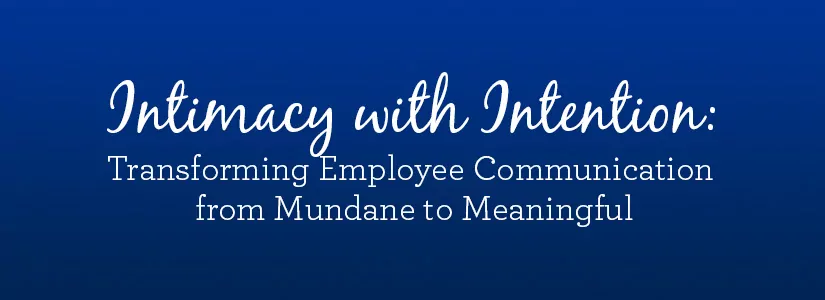Most corporate leaders believe in the power of communication to inform and engage employees. Yet most organizations use typical communication tactics that yield typical results. While intranets, newsletters, videos, and departmental and company-wide meetings are adequate informational tools, they don’t elicit meaningful feedback by their nature. Even the most well-intentioned, well-crafted employee surveys are a snapshot in time, simply describing what each individual person is thinking/feeling without any context. Read on to learn about how an atypical approach yields atypical results, driving meaningful insights for proactive leadership.
The Challenge
It’s not easy to keep a steady pulse on a growing organization. Lack of fluidity and bi-directional communication can undermine a genuine effort to keep up with change that could curb progress. So how can companies transform employee communication into a process for uncovering knowledge about current issues that could eventually stymie the organization?
Conversation: the missing link
The solution is not rocket science. It’s simply old-fashioned, face-to-face, small-group conversations in a judgment-free environment led by a CEO or designated C-level executive. These appear as natural, free-flowing discussions with no more than a dozen or so employees from a variety of areas within the company. In reality these planned, regularly occurring events are designed to proactively uncover meaningful feedback in an efficient manner. Small group conversations can unleash the power of connection, engaging employees in meaningful dialogue. Nothing tops the human-to-human connection to drive deeper understanding, surface new ideas and different perspectives, and make people feel part of something bigger and more encompassing than themselves alone.
Wondering how such a seemingly casual, yet human-centric approach could work? Well, a HealthPartners hospital and clinic site that we helped institute the process within a larger communications initiative to shape engagement showcases how this human-to-human communication can work. During the pandemic many healthcare settings saw a significant rise in employee burnout and turnover. Even in the face of COVID, this hospital and clinic maintained its monthly Munchies with Mike. The CEO has shared that he believes this program, in part, stemmed employee burnout, and produced a retention rate that was significantly higher than the system’s average.
These small group intentional conversations create new informal networks that are not hierarchical, but rather bring dispersed people together, creating new connections which by their nature eliminates silos that often prevent teamwork. These new connections can be surprisingly important.
Think about it this way: A talented individual contributor who is collaborative and a center of information, direction and sound advice for those who know them is virtually unknown within the company hierarchy. Cross-pollinated person-to-person communication empowers them to connect with others outside their immediate orbit and share their perspectives to spark new ideas. The results: greater employee engagement, retention, a more meaningful employee experience, and additional benefits for the organization such as increased efficiency. By all accounts, that’s a huge win.
Keep it relevant, regular and real
So, how is this seemingly simple human-centric approach created? Having helped clients implement these conversational efforts, we’ve created some guidelines:
- Set expectations and tone—It’s critical that the program be established as casual conversations to share work experiences and ideas in a positive environment. While these are not social gatherings or departmental meetings, adding a snack and calling them something clever (Popcorn with Pam; Munchies with Mike; Cookies with Cal) can help set a lighter tone to make participants feel at ease. A personalized invitation elevates the happening to a coveted opportunity viewed as a seat of honor.
- Timing is everything—regular quarterly (and as often as monthly) conversations allow the organization to know the leader is committed and signals the program’s importance.
- Size matters—People are more comfortable and will be able to build rapport with each other in smaller groups, so we advise limiting participants to 12, no more than 14.
- Aim for diversity—Participants from various departments and levels whose interactions wouldn’t naturally occur spark dialog that produces information that might never otherwise be revealed. Some area’s triumphs could be another’s bane.
- Coach the leader—Most executives are skilled at thinking on their feet. It’s important, however, that the leader starts each conversation by making all participants feel comfortable and an important part of the group. “I want to get to know you” is a powerful lead-in. It also helps people feel safe when the leader demonstrates their own vulnerability—perhaps by sharing a self-deprecating personal experience. Creating a list of icebreakers and questions will help them navigate diverse groups. “Tell us about your area” may be too general. Something positive like “What are the coolest aspects of your area?” could be followed up with “What are some hiccups your area has experienced?”
Where this works
This process works wherever you find people – and you treat those people like people. It’s the planned power of purposeful people-centric practices and processes. We’ve seen this process work across multiple industries, including medical devices, construction, industrial manufacturing, and financial. Opening new pathways between different parts of the organization builds a higher level of community with deeper relationships. Sharing common problems empowers participants to learn how they can help each other achieve workplace goals.
Keep in mind that these intimate conversations are but one part of an overall communication plan that supports a culture of employee engagement, inclusivity, and recognition of individual contributions. If you’re interested in learning how result-driven intimacy with intention could enhance your organization’s communications, let’s start a conversation. Call 800-742-6800 or email today. For more information and tips for engaging stakeholders, sign up for our monthly newsletter. You can find our newsletter sign-up at askhillarys.com at the bottom right corner of the page.


